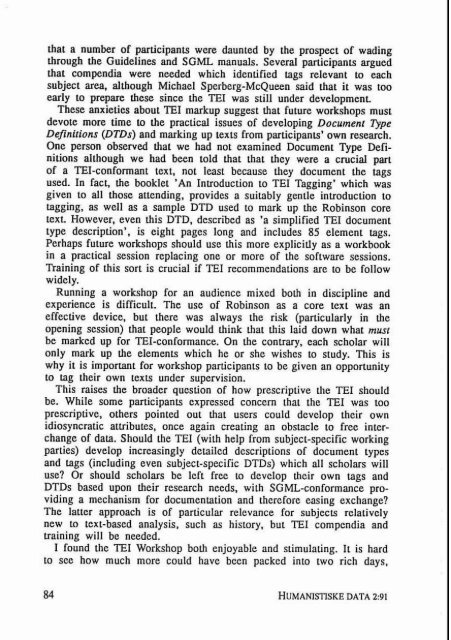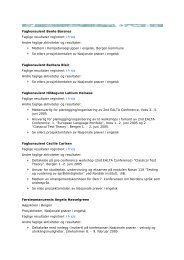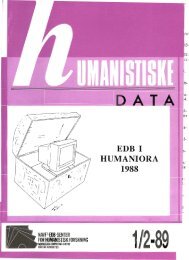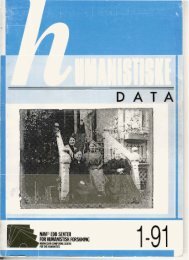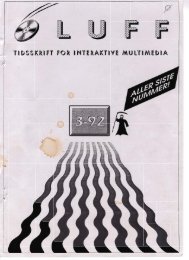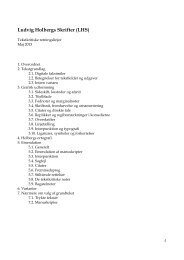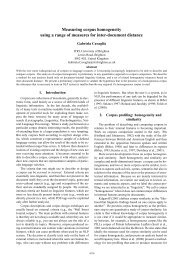1991:2 - Universitetet i Bergen
1991:2 - Universitetet i Bergen
1991:2 - Universitetet i Bergen
Create successful ePaper yourself
Turn your PDF publications into a flip-book with our unique Google optimized e-Paper software.
€hat a number of participants were daunted by the prospect of wading<br />
through the Guidelines and SGML manuals. Several participants argued<br />
that cornpendia were nded which identificd tags relerwt te each<br />
subject area, although Michael Sperberg-McQueen said that it was too<br />
earIy to prepare these since the TE1 was still under developrnent.<br />
These anxieties about TE1 markup suggest that future werkshops must<br />
devoie more time to the practical issues of developing Pocurneni Type<br />
Definitions (DTDs) and marking up texts from participanrs' own research.<br />
One person observed that we had not examined Document Type Defi-<br />
nitions aIthough we had been told that that they wcre a cmcia1 part<br />
of a TEI-conformant text, not Icast because they docurnent the tags<br />
used. In fact. the booklet 'An Introduction to TE1 Tagging' which was<br />
given to al1 thosc attending, provides a suitabIy gentle introduction to<br />
tagging, as we11 as a sample DTD used to mark up the Robinson core<br />
LexL However, even this DTD, described as 'a sirnplified TE1 document<br />
type description', is eight pages long nnd includes 85 element tags.<br />
Perhaps future workshops should use this more explicitly as a workbook<br />
in a practical session replacing one ar mare of the software sessions.<br />
Training of this sort is crucial if TEI recommendations are to be foHow<br />
widel y.<br />
Running a workshop for an audience mixed both in discipline and<br />
experience is difficult. The use of Robinson as a core text was an<br />
effective device, but there was always the risk (particularly in the<br />
opening session) that peoplc would think hat this laid down what musl<br />
be marked up for TEI-confomance. On the conrrary, each scholar wiII<br />
only mark up the eIernents which be or she wishes to study. This is<br />
why it is impomt for workshop participants to be given an opportunity<br />
to lag their own texts under supervision.<br />
This raises the broader question of how prescriptive the TE1 should<br />
be. While somc participants expressed concem mat the TE1 was too<br />
prescriptive, others pointed out hat users could develop their own<br />
idiasyncratic atcributes, once again creating an obsrncle ro frec intet-<br />
change of data. Should the TE1 (wiih help from subject-specific working<br />
parries) develop increasingly detailed descriptions of document types<br />
and tags (including cven subjecl-specific DTDs) which al1 scholars will<br />
use? Or should scholars be leit fra m devel09 Iheir own tags and<br />
DTDs based upon their research needs. wilh SGMZ-confomance pro-<br />
viding a mechanism far documentation and thereiore erising exchange?<br />
Thc latter approach is of particular relevante for su'bjecrs relalively<br />
new to text-based analysis, cuch as history. but TEI cornpendia and<br />
iraining will be needcd.<br />
I found the TE1 Workshop both enjoyable and stimularing. Il is hard<br />
to see how much more could have been packed into two tich days,<br />
84 HUMANISTISKE DATA E91


